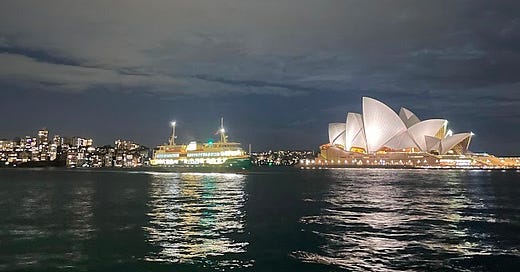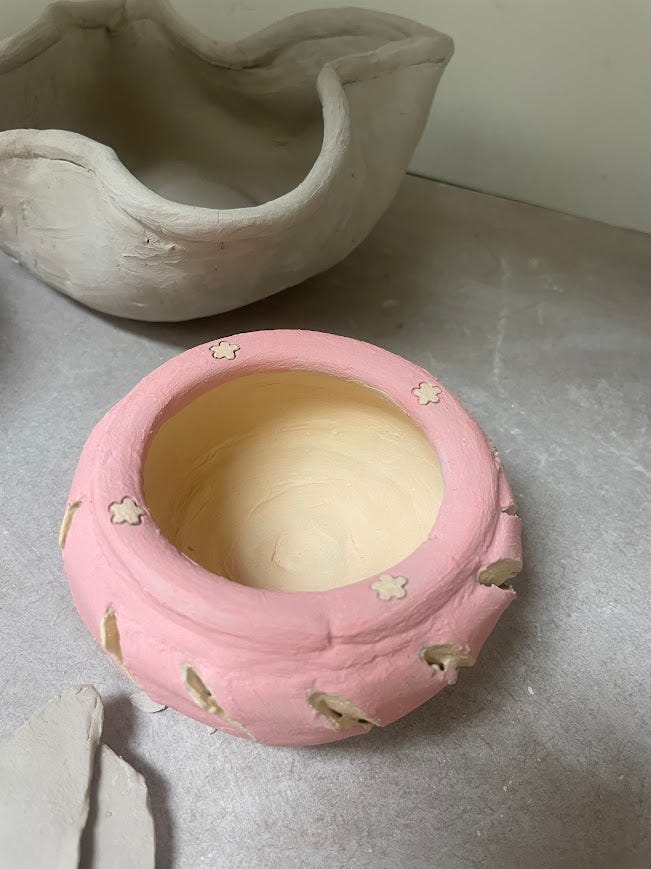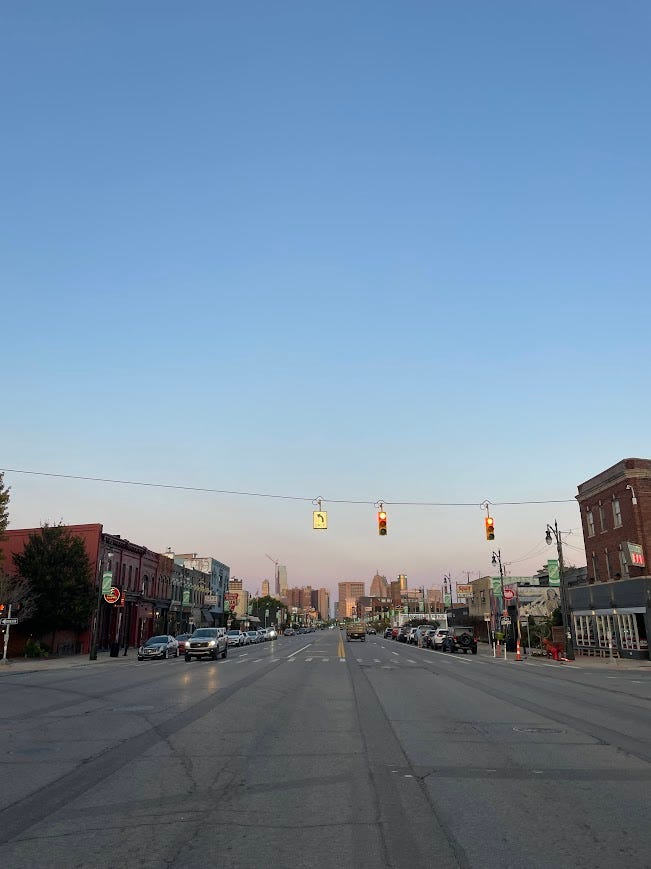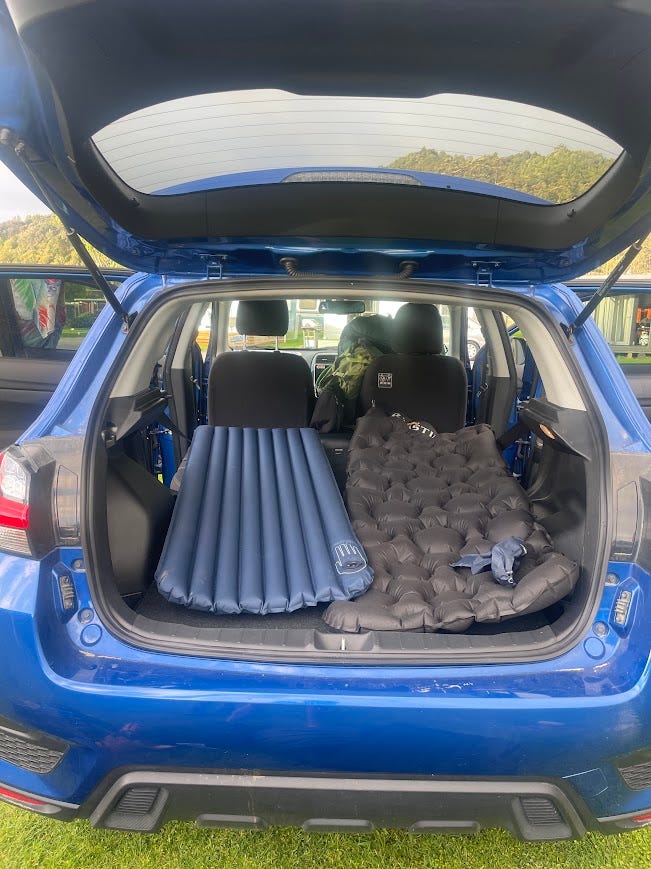It's Amazing Anything Ever Gets Made
Pottery classes and public works projects. Plus, our cat-sitting retreat!
Hi from Auckland!
We’ve just returned from a lovely road trip into the Coromandel Peninsula, which confirmed that peninsulas formed by volcanoes, like our previous residence of the Banks Peninsula, might just be my favorite landmass. On our trip back, we bunked at a wildlife refuge for viewing shorebirds that fly here non-stop all the way from the Arctic. When I last wrote, we had just arrived back in New Zealand after seven weeks away. One of our big goals for “part two” was to slow down our travels, and we’ve spent the past two to three weeks in Tauranga doing just that.

A super prominent aspect of our approach to the working holiday has been building meaningful ways to spend our time based around the loosest of ideas. We had wanted to spend more time nurturing creativity upon our return. When we were back home in the States, we had emailed a few pottery studios in New Zealand asking if we could exchange a little labor for classes. And one in Tauranga got back to us! The east coast of the North Island was also one of the few regions we had yet to explore, and we had some friends from Akaroa who had moved back to the area. The convenience of living out of a campervan is you can just move somewhere based on that little, and build from there.
Living in a van full-time in Tauranga proved to be a bit difficult. While there are a lot of freedom camping sites, most only have 2-3 parking spaces and tend to fill up before 5 PM. The weather can also be quite rainy in the spring! As we struggled to get our camping stove to work in blustery conditions, we laughed at ourselves for choosing a beautiful, coastal campsite known for…windsurfing. Thankfully, we had done our research and anticipated these challenges! Since we knew we’d be devoting a lot of time to pottery and other projects, we didn’t want to go the WWOOFing route, especially if that required a longer drive into the city. So we decided to give a go at one of the budget travel options we had yet to try – housesitting!
We found a housesitting gig in Tauranga that aligned perfectly with our dates cleaning the pottery studio, given that the two weeks revolved around New Zealand’s school holidays. We decided to think of our time in Tauranga as a little retreat, as it would be the longest period of our trip we would be spending in an indoor home to ourselves. And we’ve had the cuddliest, most playful kitten as a companion!

How I’d Spend My Time If I Didn’t Have to Work: Domestic Edition
I often have hypothetical conversations with friends about how we would spend our days if we didn’t have to work. Some people talk about careers they’d try if they didn’t have to worry about it being profitable, and others daydream about the luxury of just lazing around. A lot of people say it would be daunting – it’s too hard to imagine a sense of direction without the structure of work. I’ve always said that it would be easy for me to fill my time with creative projects. But as I wrote about in my last post, we’ve filled quite a bit of time this year doing some form of work, paid or volunteer. When we aren’t cleaning bird feeders or waiting tables, we’ve spent most of our free time enjoying the outdoors.
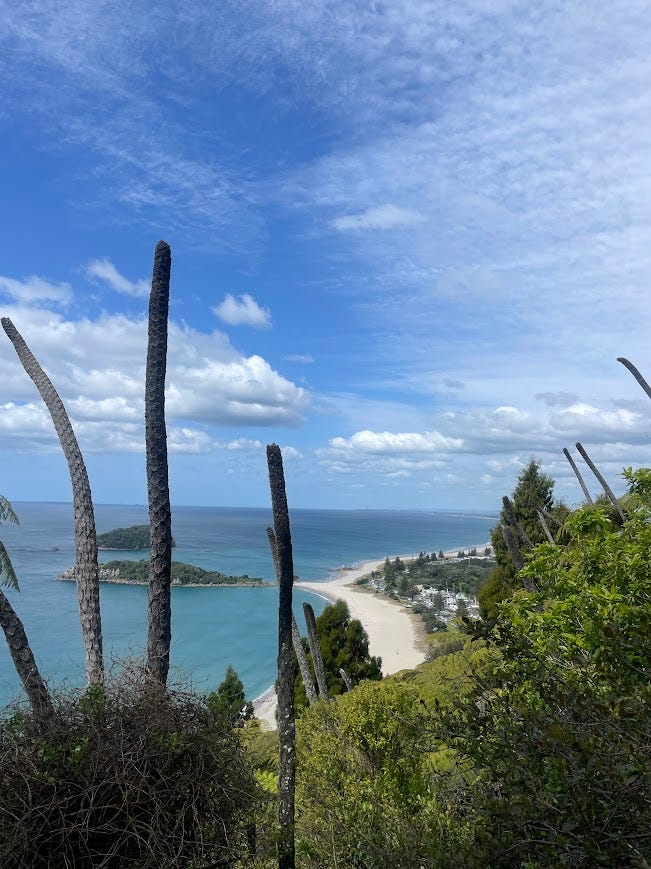
During our time in Tauranga, we’ve been able to find out specifically what we would do if we didn’t have to work and weren’t in a state of constant travel. It’s been a really nice change of pace! Each day, the kitten wakes us up early for his breakfast. Chris puts a homemade loaf of bread in the oven while I try to squeeze in some more sleep before we head to the pottery studio to clean it! We head back for breakfast, and then settle into our various projects. We’ve both been doing some writing – as planned, I wrote a first draft of a short story and a journalism piece. I’ve been cooking recipes that I can’t with only a camping stove, and Chris has been baking up a storm! He’s learned to make a classic Kiwi “slice,” Chinese egg tarts, and various cookies. We’ve started studying Korean in anticipation of our future travels (stay tuned!) Ironically, while camping full-time, it can sometimes be hard to do certain types of physical activity, since we don’t always have easy access to a shower at all times of day. I’ve fallen back into a rhythm of getting outside through running and a little mountain biking! Most days, we also spend a few hours at the pottery studio – practicing our wheel skills or building from slab. I feel lucky to have tried pottery for free (!) over the course of a few weeks, as most of what you make when you first start is pretty bad! And we’ve spent a lot of time researching and planning our next steps. For the first time this year, we have figured out our plans almost three months into the future. And of course we spend plenty of time playing with the cat, who has helped confirm that we’re getting one as soon as practically possible.
What I’ve Been Thinking About Lately: How Things Get Made
I’ve never had a desire to make this newsletter a travelogue. There are people far more suited than me to make this type of writing compelling. I often joke that most of my posts don’t even necessarily have anything to do with New Zealand. But on my recent trip to Detroit, I spent a lot of time with friends with a common interest in urban planning. I meandered through the city’s oldest neighborhood, Corktown, with my friends talking about good and bad development patterns and thought, is there anything that makes me feel more like myself than walking around a city with other people who love to think about cities?
My friend and also I did our own little walking tour of some of the city’s most stunning architecture built during the city’s peak economic prosperity, like a parking garage that retains opulent ceilings from when it used to be the grand Michigan Theatre. It was striking to see what architecture remains in a city that experienced such drastic disvinvestment, depopulation, and demolition. While many of these buildings were privately constructed, many are of civic significance, and some are now publicly owned. We talked about how to weigh the societal benefit of beautiful buildings, of luxury for the people.
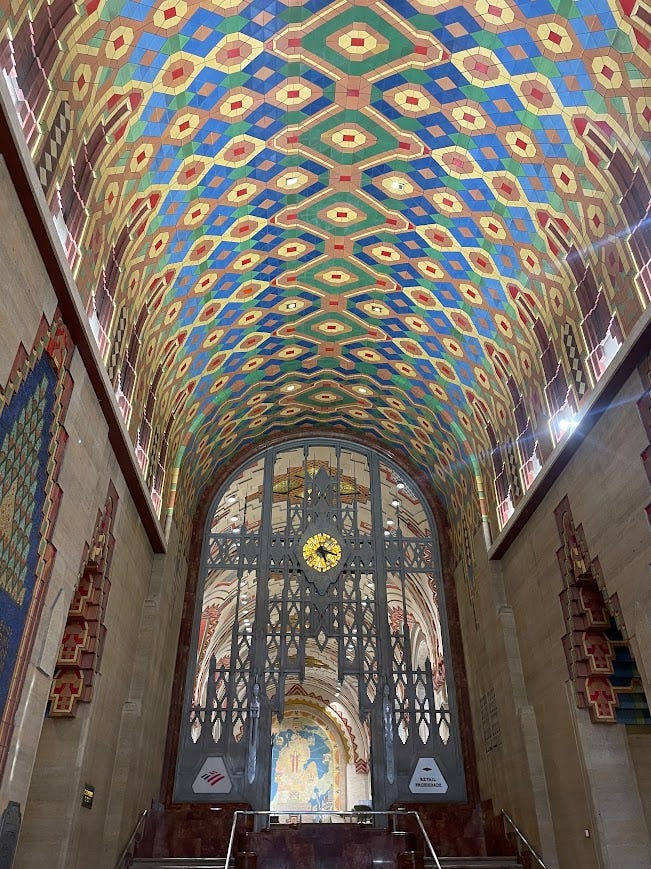
These conversations brought up so many previously submerged reflections about the places we have visited this year, convincing me I had more to say about them in this newsletter! I imagined doing a deep dive into some of the places we have visited, but to be honest, my other two writing projects have taken up all my brain space! In the spirit of not abandoning this newsletter for those projects, I’ll just share my half-baked thoughts that I’ve been drafting for almost two months (!) I hope it feels like an conversation with me, meandering and unfinished, and that it still lends insight into some of the travel I’ve described less thoroughly in this newsletter.
Since our first few pottery sessions, Chris has frequently remarked, “it’s amazing anything ever gets made.” Learning pottery has reinforced the immense skill that goes into it, as well as the fragility of creating things! A creation can get damaged, break, or explode at pretty much any stage in the process, so any piece that makes it out of the kiln is one to be grateful for. To pass the time cleaning the pottery studio, we’ve been listening to GBH’s Peabody Award-winning podcast on the most expensive highway project in American history, the Boston Central Artery/Tunnel Project, colloquially known as the Big Dig. Many of the episodes return to the same question: why is it so hard to build infrastructure? Whether it be the politics, the cost, the administration, the public support (or lack thereof), there are so many reasons a project can die before it even gets off of, or into, the ground. On a much broader scale than our handmade mugs and bowls, the host remarks that it’s a miracle anything ever gets built. Nowhere has reinforced this feeling more than seeing one of the world’s great architectural masterpieces: the Sydney Opera House.
While we only spent a day and some change (my birthday, to be specific!) in Sydney, it was memorable! I had a hazelnut milkshake that changed my life. We saw a show at the Sydney Theatre Company and feasted from a hole-in-a-parking-lot Egyptian vegetarian food truck. I realized that there’s no better way for me to spend a birthday than live theater and a meal where I get to try a bunch of little dishes. Bring on the ramekins! But the most remarkable sight of our time in Sydney was also the most obvious, and we agreed it lives up to its reputation. We first saw the Opera House from Circular Quay, walking on the wharf between the monument and its visual counterpart, the Sydney Harbour Bridge. And we came back to see it two more times! Once up close in the evening hours, when light and shadow accentuate its dramatic shell-like structures, and again the next day from the Royal Botanic Gardens (one day I’ll have to do a deep dive on the remarkable, always free botanic gardens in NZ/Aus). I couldn’t stop marveling, not only at the striking shape, but at the fact that they managed to build it at all.
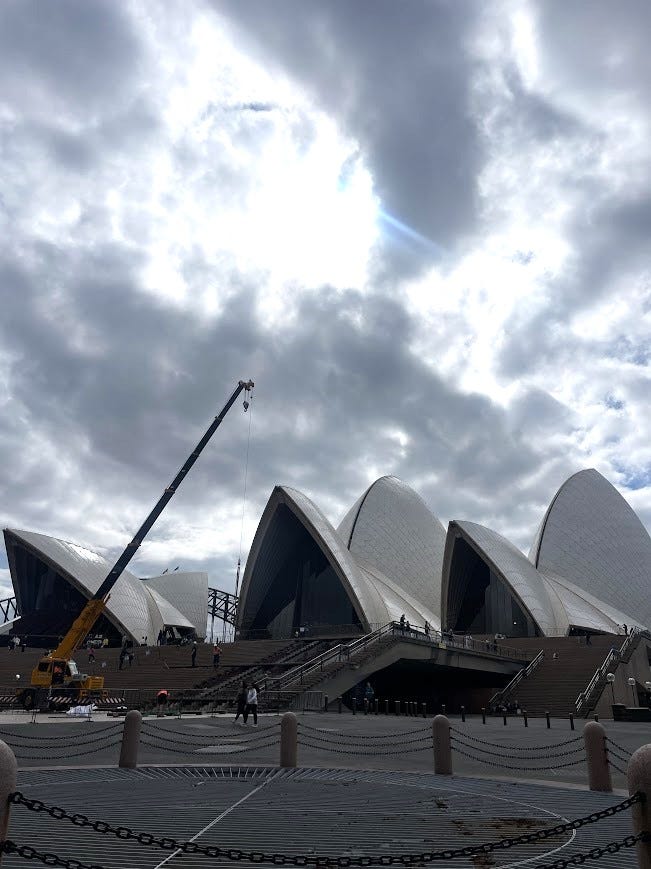
Much less ambitious projects than the Opera House have failed, and the project was no stranger to the classic problems of time, cost, and drama. In 1957, it had a projected cost of $7 million Australian pounds, and a completion date of 1963. In 1973, 10 years late, the opera house was completed at a cost of $102 million Australian dollars (equivalent), over 13 times greater than its original budget. No, you did not catch a typo – the project took so long that it spanned a period where Australia changed its national currency. There were numerous problems with construction, most notably that the original columns had to be rebuilt, as they were not strong enough to support the roof. In interesting labor history, labor disputes led to a “work-in,” where construction workers overthrew management, completed the work more efficiently themselves, and eventually won both better pay and reduced hours. Citing being pushed out by the government, the architect resigned several years into the project and would never return to see it completed. It would be easy to argue that, a la the Big Dig, the project was a fiasco. But it’s hard to argue with the results. A UNESCO World Heritage Site, it has almost 11 million visitors a year, has an estimated social asset value of $11.4 billion USD, and generates $558 million per year in tourist spending for the Australian economy.
Across the ditch, New Zealand towns love a theme, but the small nation isn’t really big on monuments. One of its few major recognizable structures, the Christchurch Cathedral, was destroyed in the region’s disastrous earthquake in 2011. During our time in Akaroa (about 90 minutes outside Christchurch), we encountered a plea for public donations to rebuild the cathedral. Perhaps it is because New Zealand is in a recession, or because we come from a nation where public infrastructure is chronically underfunded, but we just couldn’t stomach how much it would cost to rebuild the cathedral. Initial estimates stood at $104 million NZD, and were increased in 2024 to $248 million NZD (about $150 million USD). It begs the question at what point is it not worth it to build (or to rebuild)? In the case of the cathedral, the government has decided that point is after 4 years of construction challenges and $84 million spent, pulling taxpayer funding on the project in August.
Last year, in Paris, we saw the earliest phases of another cathedral restoration: Notre Dame, which had its spire, roof, and other features seriously damaged by fire in 2019. No one seems to question whether the cathedral should be rebuilt, but rather there is opposition to any changes that could threaten its original architectural integrity. While the Christchurch Cathedral is in the Little Leagues compared to Notre Dame, both are historically significant focal points of their respective cities, and their rebuilds have been supported by UNESCO World Heritage Centre, the global authority on legally protecting significant landmarks. It makes me wonder at what point a building becomes so locally iconic, like Notre Dame or the Sydney Opera House (but apparently not the Christchurch Cathedral), that virtually no cost would be too high to restore or rebuild it. In the case of Notre Dame, private citizens from all over the world donated over $800 million to restore it, so much that there was concern it would be too much money! But these types of projects have a way of endlessly expanding costs. As The Big Dig hosts put it, “as long as people believed the price could keep going up, it would keep going up. Give a hundred, it'll go up a thousand. Give a thousand, it'll go up a million.”
Of course, public works and monuments aren’t just about costs and revenue. Cities are for people! Great public spaces and landmarks are often at the heart of what makes a place and gives it an identity. As a high schooler, my first exposure to these types of great spaces are what inspired me to go into urban planning. Yet as a practitioner, ambitious public works projects are far from top of mind. As a transportation planner, it was sometimes a feat to even complete a feasibility study for a modest bike path, much less a complete project of greater scale. In my work in local government, budgets for amenities like parks and rec centers were being slashed and reallocated to address overlapping crises. It’s hard for me to imagine when would be a good time to embark on a major public works project. Of course,,these tradeoffs are to some extent contrived. Budgets are an expression of our values, and most people can probably imagine what they would cut first if given the authority. I’m left pondering the following questions: can we only aspire to build ambitious projects in times of economic prosperity? How do we balance the potential benefits of big public works projects with their massive costs, when few, if any, cities are adequately funding desperately needed social services? Is it useful to find or create a connection between the “business case” for these projects and building more equitable cities? Can women really have it all??? Social services and quality infrastructure, that is. Would love to hear any and all thoughts!
What’s next?
We ended our time in a Tauranga with a big win — we sold our campervan! We had planned to WWOOF in Auckland for our last two weeks before heading back down South in order to give ample time to sell our van. But we managed to find a buyer in Tauranga, which is a huge weight lifted off our shoulders. Our first van broke down on an attempt to see the Southern Lights, which mysteriously returned last week as we were selling our second van. Needless to say, we were a little superstitious and eager to pass Goldie II along to her next owner. We felt like we transitioned out of vanlife at a good time, while it still felt nostalgic and before the stressors outweighed the benefits. And a subpar night’s sleep in a compact rental car will quickly reinforce just how comfortable our van really was!
We’ve just made it to Auckland for our WWOOFing stay. We really haven’t spent that much time in the city or its surrounding islands, so we’re looking forward to some extended time here. Then we’ll fly South for our much anticipated backpacking trips, before ending our working holiday in the middle of November! After a lot of reflection, we decided we felt satisfied with our time in New Zealand and were ready for the next stage of our journey, which we had always anticipated would be in Asia! To build relationships and keep our travels cheap, we knew we wanted to volunteer in some capacity. Our research resulted in reaching out to a few “language cafes” in different cities, where locals go to practice English conversation. In return for volunteering as conversation partners about 15 hours a week, we get free lodging. One got back to us with availability in Busan, South Korea, so that’s where we are headed next! I am deep into Duolingo, and really enjoying the challenge of learning my first new language since I started Spanish and Latin in middle school! Definitely much more to come!

